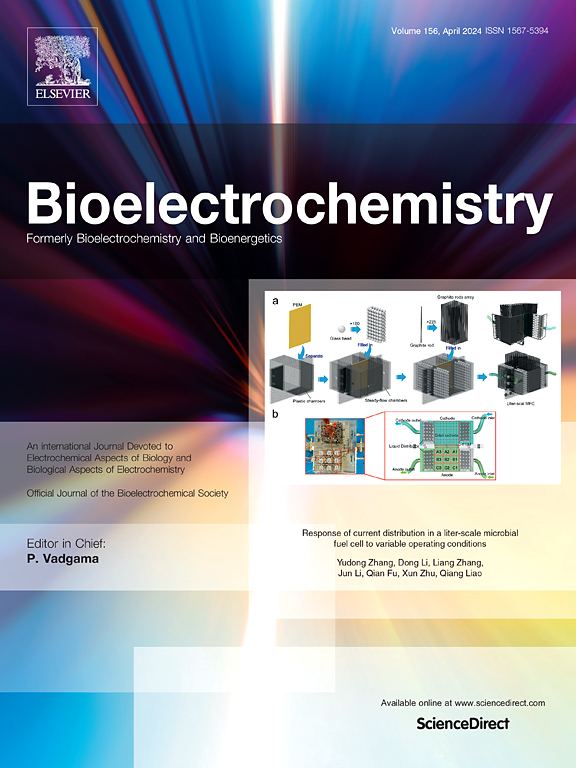基于aunps -富勒烯纳米复合材料的肿瘤抗原125无标记免疫传感器的研制。
IF 4.8
2区 化学
Q1 BIOCHEMISTRY & MOLECULAR BIOLOGY
引用次数: 0
摘要
本研究合成了金纳米粒子(AuNPs),并与富勒烯结合,形成纳米复合结构。然后用扫描电子显微镜(SEM)和能量色散x射线能谱(EDX)技术对其结构进行了表征。用MPA对纳米结构进行功能化,并将其用于CA125抗体的共价结合,利用抗体结合的纳米复合结构对SPE表面进行修饰。免疫传感器的表面被Nafion保护,免疫传感器设计的各个阶段用CV和EIS进行表征。采用EIS法测定CA125,浓度线性范围为1 ~ 100 U·mL-1, LOD值为0.016 U·mL-1。该免疫传感器可选择性识别CEA、NSE、HSA和IgG蛋白,具有良好的重复性。制备的免疫传感器在30天后仍有80.9%的活性。此外,该免疫传感器可以成功地应用于常规的临床人血清。与现有文献的比较表明,该免疫传感器具有低LOD和高稳定性的优点。此外,与商业套件相比,较短的分析时间被认为是一个显著的优势。所制备的免疫传感器显示了测定CA125的有价值的特性,并且具有开发用于健康应用的潜力。本文章由计算机程序翻译,如有差异,请以英文原文为准。
Development of label-free immunosensors based on AuNPs-fullerene nanocomposites for the determination of cancer antigen 125
In this study, gold nanoparticles (AuNPs) were synthesized and combined with fullerene, resulting in the formation of nanocomposite structures. The structures were then characterized by scanning electron microscopy (SEM) and energy-dispersive X-ray spectroscopy (EDX) techniques. The nanostructures were functionalized with MPA and employed for covalent binding of CA125 antibody, whereby the antibody-bound nanocomposite structure was utilized for modification of the surface of the SPE. The surface of the immunosensor was protected by Nafion, and the individual stages of the immunosensor design were characterized by CV and EIS. CA125 determination was conducted using the EIS technique, which revealed a linear concentration range of 1–100 U·mL−1 and a LOD value of 0.016 U·mL−1. The immunosensor demonstrated selective recognition of CEA, NSE, HSA, and IgG proteins, exhibiting good reproducibility. The prepared immunosensor demonstrated 80.9% activity even after a 30-day period. Moreover, this immunosensor can be successfully employed in conventional clinical human serum applications. A comparison with existing literature reveals that the superior features of this immunosensor are its low LOD and high stability. Additionally, the short analysis time in comparison to commercial kits is considered a significant advantage. The prepared immunosensor displays valuable characteristics for the determination of CA125, and it has the potential to be developed for use in health applications.
求助全文
通过发布文献求助,成功后即可免费获取论文全文。
去求助
来源期刊

Bioelectrochemistry
生物-电化学
CiteScore
9.10
自引率
6.00%
发文量
238
审稿时长
38 days
期刊介绍:
An International Journal Devoted to Electrochemical Aspects of Biology and Biological Aspects of Electrochemistry
Bioelectrochemistry is an international journal devoted to electrochemical principles in biology and biological aspects of electrochemistry. It publishes experimental and theoretical papers dealing with the electrochemical aspects of:
• Electrified interfaces (electric double layers, adsorption, electron transfer, protein electrochemistry, basic principles of biosensors, biosensor interfaces and bio-nanosensor design and construction.
• Electric and magnetic field effects (field-dependent processes, field interactions with molecules, intramolecular field effects, sensory systems for electric and magnetic fields, molecular and cellular mechanisms)
• Bioenergetics and signal transduction (energy conversion, photosynthetic and visual membranes)
• Biomembranes and model membranes (thermodynamics and mechanics, membrane transport, electroporation, fusion and insertion)
• Electrochemical applications in medicine and biotechnology (drug delivery and gene transfer to cells and tissues, iontophoresis, skin electroporation, injury and repair).
• Organization and use of arrays in-vitro and in-vivo, including as part of feedback control.
• Electrochemical interrogation of biofilms as generated by microorganisms and tissue reaction associated with medical implants.
 求助内容:
求助内容: 应助结果提醒方式:
应助结果提醒方式:


